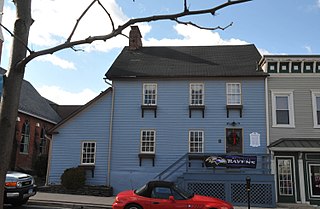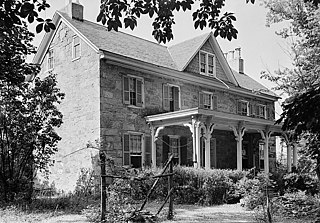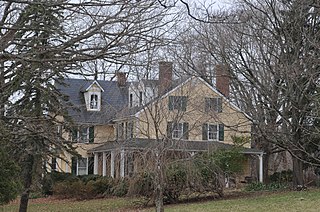
Churchville is an unincorporated community in Harford County, Maryland, United States, situated between the county seat, Bel Air, and Aberdeen, where Aberdeen Proving Ground is located.

The Nelson-Reardon-Kennard House, also known as the Methodist Parsonage, is a historic home located at Abingdon, Harford County, Maryland, United States. It is a two-part frame house, with a five-bay, two-story front section built about 1785 and a three-bay, one-room rear service wing. The front porch dates to 1888. It is the oldest documented frame dwelling in Harford County.

The Graham-Crocker House is a historic home located at 30 North Main Street, Bel Air, Harford County, Maryland, United States. It is a 2+1⁄2-story frame dwelling with a shed addition to the south and an ell to the west, and dating to about 1825.

The Hays House is a historic home located at 324 South Kenmore Avenue, Bel Air, Harford County, Maryland, United States. It is a frame 1+1⁄2-story house with a gambrel roof, likely built in 1788 with an addition in 1811. The house was moved in 1960, and stands on a modern concrete-block foundation. The Hays House is owned by The Historical Society of Harford County and today the Hays House Museum offers visitors a glimpse into the life of an affluent family in late 18th century Bel Air.

The Hays-Heighe House is a historic home located on the campus of Harford Community College near Bel Air, Harford County, Maryland, United States. It is a five bay long, two bay deep stone house with a gable roof and massive brick chimneys on each gable, built in 1808. On the east is a five bay long, two-story stone wing. Its initial owner, Thomas A. Hays, was one of the founders of the town of Bel Air.

Proctor House, also known as the Cassandra Gilbert House, is an historic home located at Bel Air, Harford County, Maryland, United States. It is a two-story detached Carpenter Gothic style cottage with board and batten siding, constructed between 1860 and 1873 and enlarged about 1884. The interior features an arched slate mantel painted to resemble several colors of inlaid marble.

The Col. John Streett House is a historic home located at Street, Harford County, Maryland, United States. It is a Federal style home composed of three brick sections, two of which are original and one a late 19th-century addition. The original dwelling built about 1805, consists of a 2+1⁄2-story, five-bay, gable-roofed main section and a 2-story, two-bay attached kitchen. The kitchen wing section has two unequal-sized rooms on the ground floor and a large loft room above, reached by a closed, corner stair. The home is named for Colonel John Streett (1762-1837), a man prominent in local politics and a hero of the War of 1812 who led Harford's 7th Regiment Cavalry at the Battle of North Point.

Priest Neal's Mass House and Mill Site, also known as Paradice, is a historic Roman Catholic Church located at Bel Air, Harford County, Maryland. It is a stuccoed, 1+1⁄2-story stone dwelling constructed about 1743 by Jesuits for use as a mission before Roman Catholics obtained freedom of worship under the United States Constitution. The interior floor plan is unique in its combined function as Jesuit priests' residence and house of worship: an unusually wide center hall provided meeting space and was flanked by two chambers on the west and a large reception room on the east. On the banks of Deer Creek, is the site of an 18th-century mill which the priests used to generate money to support their endeavors. It is one of the oldest extant buildings associated with the Catholic Church in America.
Whiteford is an unincorporated community in Harford County, Maryland, United States. The community has historically had a strong Welsh heritage, which is reflected in the local architecture.

Bel Air Courthouse Historic District is a national historic district at Bel Air, Harford County, Maryland, United States. It consists of a small cohesive group of buildings, mostly two or three stories of brick or frame construction that were erected or renovated in the 19th to early 20th century period and border the Harford County Courthouse which is a grand scale brick structure.

Harford Furnace Historic District is a national historic district at Bel Air, Harford County, Maryland, United States. It consists of five standing structures and several archeological sites associated with the operation of the iron furnace which began about 1830 and continued to function until 1876. They cover approximately 30 acres (120,000 m2) of rolling land. The district side is both open and wooded and includes land on both sides of James Run, a small south-flowing tributary of the Bush River.

Heighe House is a historic home complex and national historic district at Bel Air, Harford County, Maryland, United States. The complex consists of a Colonial Revival, 2+1⁄2-story stone main house built on and incorporating the stone foundations of the Moores Mill, built in 1745; a 1+1⁄2-story frame chauffeur's cottage; garage; and a 1+1⁄2-story stone and frame guest house. They are all located on a steeply sloping 17-acre (69,000 m2) site along Bynum Run. The property was developed in 1928 as a country estate for Anne McElderry Heighe, a woman widely regarded as the "first lady of Maryland racing."

Berkley Crossroads Historic District is a historic district in Darlington, Maryland, United States. It is a small rural crossroads community dating from the late 18th century through the early 20th century, and is one of the few remaining rural crossroads in Harford County. The entire area is agricultural in nature, and mostly consists of two- and three-story residences. The earliest structures, dating from the late 18th and early 19th century are of log construction, in whole or in part. It was also an important 19th century Free Black community.

Lower Deer Creek Valley Historic District is a national historic district near Darlington, Harford County, Maryland, United States. It comprises approximately 15,020 acres (60.8 km2) in north central Harford County. The primary building material is stone taken from local quarries and used to construct houses, mills, schoolhouses, and churches. Also constructed of stone are many dependencies including springhouses, stables, tenant houses, meathouses, ice houses, and barns. The district's contributing standing structures date from the mid 18th century to the 1940s, and mostly built in vernacular styles. The valley contains approximately 350 separate historic properties.

Silver Houses Historic District is a national historic district near Darlington, Harford County, Maryland, United States. It is a group of mid-19th century farmsteads and a church in rural east central Harford County. The district comprises a total of 36 resources, including four stone residences with related agricultural outbuildings, and the site of a fifth stone house, marked by a large frame barn, a frame tenant house, and two outbuildings. The houses were built between 1853 and 1859 by members of the Silver family. The district also includes the Deer Creek Harmony Presbyterian Church, a Gothic-influenced stone building of 1871, designed by John W. Hogg.

Medical Hall Historic District is a historic home and national historic district near Churchville, Harford County, Maryland, United States. The home was constructed of stuccoed stone between 1825 and 1840 and is five bays long, two bays wide, and two and a half stories high. The façade features a centrally placed door with sidelights and a rectangular transom subdivided in a radiating pattern. Also on the property is a stone springhouse which 20th century owners have converted into a pumphouse and a stone cottage believed to be a 19th-century tenant house. The property is associated with John Archer (1741–1810), the first man to receive a degree in medicine in America. One of his sons was Congressman, judge of the circuit court, and Chief Justice of Maryland Stevenson Archer (1786–1848).

Havre de Grace Historic District is a national historic district at Havre de Grace, Harford County, Maryland, United States. It is an urban district of approximately a thousand buildings and includes the central business district and most of the residential neighborhoods radiating out of it. The buildings date primarily from the 19th and early 20th centuries.

The Southern Terminal, Susquehanna and Tidewater Canal is a national historic district at Havre de Grace, Harford County, Maryland, United States. Located along the western bank of the Susquehanna River near its mouth at the Chesapeake Bay, it includes the Lock Master's House, the canal's outlet lock, and the foundations of a bulkhead wharf along the river side of the lock. Most of the structures built to serve aspects of the Susquehanna and Tidewater Canal operations are no longer standing, but the locations of warehouses, stables, and several other buildings, including a broom factory, are shown on old city maps.

Whitaker's Mill Historic District is a national historic district near Joppa, Harford County, Maryland, United States. It includes three early- to mid-19th-century buildings: the 2+1⁄2-story rubble stone Whitaker's Mill built in 1851, the 1+1⁄2-story rubble stone miller's house, and the log-and-frame Magness House, begun about 1800 as the miller's house for the first mill on the site. The district also includes an iron truss bridge known as Harford County Bridge No. 51, constructed in 1878, and the oldest such span in the county. The grist mill closed operations about 1900.

Whiteford–Cardiff Historic District is a national historic district at Cardiff and Whiteford, Harford County, Maryland, United States. It encompasses portions of two communities in northern Harford County that were historically associated with slate production during the late 19th and early 20th centuries. It contains 140 contributing resources including four vernacular Welsh cottages dating to about 1850. The Whiteford–Cardiff area is noted for its strong Welsh ethnic identity, which is reflected in the architecture of the area.























